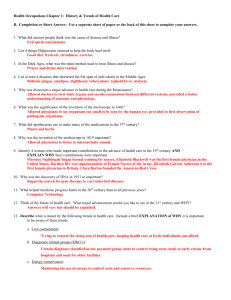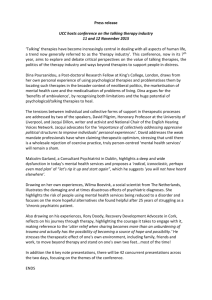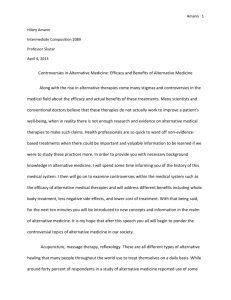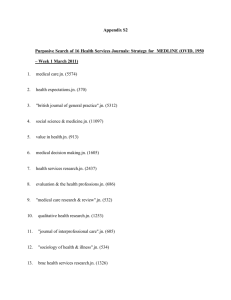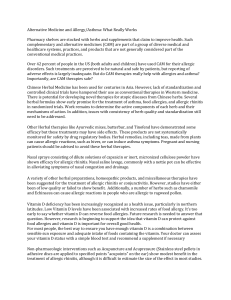Read more…
advertisement
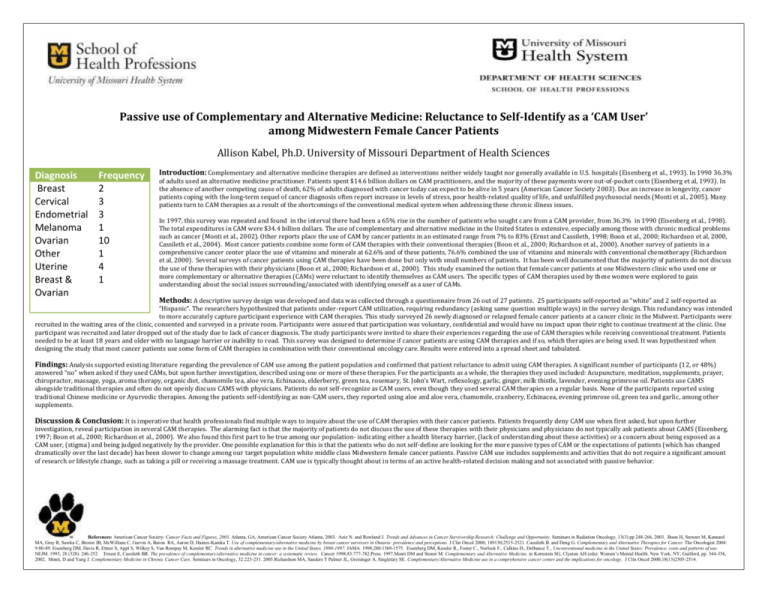
Passive use of Complementary and Alternative Medicine: Reluctance to Self-Identify as a ‘CAM User’ among Midwestern Female Cancer Patients Allison Kabel, Ph.D. University of Missouri Department of Health Sciences Diagnosis Breast Cervical Endometrial Melanoma Ovarian Other Uterine Breast & Ovarian Frequency 2 3 3 1 10 1 4 1 Introduction: Complementary and alternative medicine therapies are defined as interventions neither widely taught nor generally available in U.S. hospitals (Eisenberg et al., 1993). In 1990 36.3% of adults used an alternative medicine practitioner. Patients spent $14.6 billion dollars on CAM practitioners, and the majority of these payments were out-of-pocket costs (Eisenberg et al, 1993). In the absence of another competing cause of death, 62% of adults diagnosed with cancer today can expect to be alive in 5 years (American Cancer Society 2003). Due an increase in longevity, cancer patients coping with the long-term sequel of cancer diagnosis often report increase in levels of stress, poor health-related quality of life, and unfulfilled psychosocial needs (Monti et al., 2005). Many patients turn to CAM therapies as a result of the shortcomings of the conventional medical system when addressing these chronic illness issues. In 1997, this survey was repeated and found in the interval there had been a 65% rise in the number of patients who sought care from a CAM provider, from 36.3% in 1990 (Eisenberg et al., 1998). The total expenditures in CAM were $34.4 billion dollars. The use of complementary and alternative medicine in the United States is extensive, especially among those with chronic medical problems such as cancer (Monti et al., 2002). Other reports place the use of CAM by cancer patients in an estimated range from 7% to 83% (Ernst and Cassileth, 1998; Boon et al., 2000; Richardson et al, 2000, Cassileth et al., 2004). Most cancer patients combine some form of CAM therapies with their conventional therapies (Boon et al., 2000; Richardson et al., 2000). Another survey of patients in a comprehensive cancer center place the use of vitamins and minerals at 62.6% and of these patients, 76.6% combined the use of vitamins and minerals with conventional chemotherapy (Richardson et al, 2000). Several surveys of cancer patients using CAM therapies have been done but only with small numbers of patients. It has been well documented that the majority of patients do not discuss the use of these therapies with their physicians (Boon et al., 2000; Richardson et al., 2000). This study examined the notion that female cancer patients at one Midwestern clinic who used one or more complementary or alternative therapies (CAMs) were reluctant to identify themselves as CAM users. The specific types of CAM therapies used by these women were explored to gain understanding about the social issues surrounding/associated with identifying oneself as a user of CAMs. Methods: A descriptive survey design was developed and data was collected through a questionnaire from 26 out of 27 patients. 25 participants self-reported as “white” and 2 self-reported as “Hispanic”. The researchers hypothesized that patients under-report CAM utilization, requiring redundancy (asking same question multiple ways) in the survey design. This redundancy was intended to more accurately capture participant experience with CAM therapies. This study surveyed 26 newly diagnosed or relapsed female cancer patients at a cancer clinic in the Midwest. Participants were recruited in the waiting area of the clinic, consented and surveyed in a private room. Participants were assured that participation was voluntary, confidential and would have no impact upon their right to continue treatment at the clinic. One participant was recruited and later dropped out of the study due to lack of cancer diagnosis. The study participants were invited to share their experiences regarding the use of CAM therapies while receiving conventional treatment. Patients needed to be at least 18 years and older with no language barrier or inability to read. This survey was designed to determine if cancer patients are using CAM therapies and if so, which therapies are being used. It was hypothesized when designing the study that most cancer patients use some form of CAM therapies in combination with their conventional oncology care. Results were entered into a spread sheet and tabulated. Findings: Analysis supported existing literature regarding the prevalence of CAM use among the patient population and confirmed that patient reluctance to admit using CAM therapies. A significant number of participants (12, or 48%) answered “no” when asked if they used CAMs, but upon further investigation, described using one or more of these therapies. For the participants as a whole, the therapies they used included: Acupuncture, meditation, supplements, prayer, chiropractor, massage, yoga, aroma therapy, organic diet, chamomile tea, aloe vera, Echinacea, elderberry, green tea, rosemary, St. John’s Wart, reflexology, garlic, ginger, milk thistle, lavender, evening primrose oil. Patients use CAMS alongside traditional therapies and often do not openly discuss CAMS with physicians. Patients do not self-recognize as CAM users, even though they used several CAM therapies on a regular basis. None of the participants reported using traditional Chinese medicine or Ayurvedic therapies. Among the patients self-identifying as non-CAM users, they reported using aloe and aloe vera, chamomile, cranberry, Echinacea, evening primrose oil, green tea and garlic, among other supplements. Discussion & Conclusion: It is imperative that health professionals find multiple ways to inquire about the use of CAM therapies with their cancer patients. Patients frequently deny CAM use when first asked, but upon further investigation, reveal participation in several CAM therapies. The alarming fact is that the majority of patients do not discuss the use of these therapies with their physicians and physicians do not typically ask patients about CAMS (Eisenberg, 1997; Boon et al., 2000; Richardson et al., 2000). We also found this first part to be true among our population- indicating either a health literacy barrier, (lack of understanding about these activities) or a concern about being exposed as a CAM user, (stigma) and being judged negatively by the provider. One possible explanation for this is that the patients who do not self-define are looking for the more passive types of CAM or the expectations of patients (which has changed dramatically over the last decade) has been slower to change among our target population white middle class Midwestern female cancer patients. Passive CAM use includes supplements and activities that do not require a significant amount of research or lifestyle change, such as taking a pill or receiving a massage treatment. CAM use is typically thought about in terms of an active health-related decision making and not associated with passive behavior. References: American Cancer Society: Cancer Facts and Figures, 2003. Atlanta, GA, American Cancer Society Atlanta, 2003. Aziz N. and Rowland J. Trends and Advances in Cancer Survivorship Research: Challenge and Opportunity. Seminars in Radiation Oncology, 13(3) pp 248-266, 2003. Boon H, Stewart M, Kennard MA, Gray R, Sawka C, Brown JB, McWilliam C, Garvin A, Baron RA, Aaron D, Haines-Kamka T. Use of complementary/alternative medicine by breast cancer survivors in Ontario: prevalence and perceptions. J Clin Oncol 2000; 189130;2515-2521. Cassileth B. and Deng G. Complementary and Alternative Therapies for Cancer. The Oncologist 2004: 9:80-89. Eisenberg DM, Davis R, Ettner S, Appl S, Wilkey S, Van Rompay M, Kessler RC. Trends in alternative medicine use in the United States, 1990-1997. JAMA. 1998;280:1569-1575. Eisenberg DM, Kessler R., Foster C., Norlock F., Calkins D., Delbance T., Unconventional medicine in the United States: Prevalence, costs and patterns of use. NEJM. 1993; 28 (328): 246-252. Ernest E, Cassileth BR. The prevalence of complementary/alternative medicine in cancer: a systematic review. Cancer 1998;83:777-782.Press. 1997.Monti DM and Stoner M: Complementary and Alternative Medicine, in Kornstein SG, Clyaton AH (eds): Women’s Mental Health. New York, NY, Guilford, pp. 344-356, 2002. Monti, D and Yang J. Complementary Medicine in Chronic Cancer Care. Seminars in Oncology, 32:225-231. 2005.Richardson MA, Sanders T Palmer JL, Greisinger A, Singletary SE. Complementary/Alternative Medicine use in a comprehensive cancer center and the implications for oncology. J Clin Oncol 2000;18(13)2505-2514.
